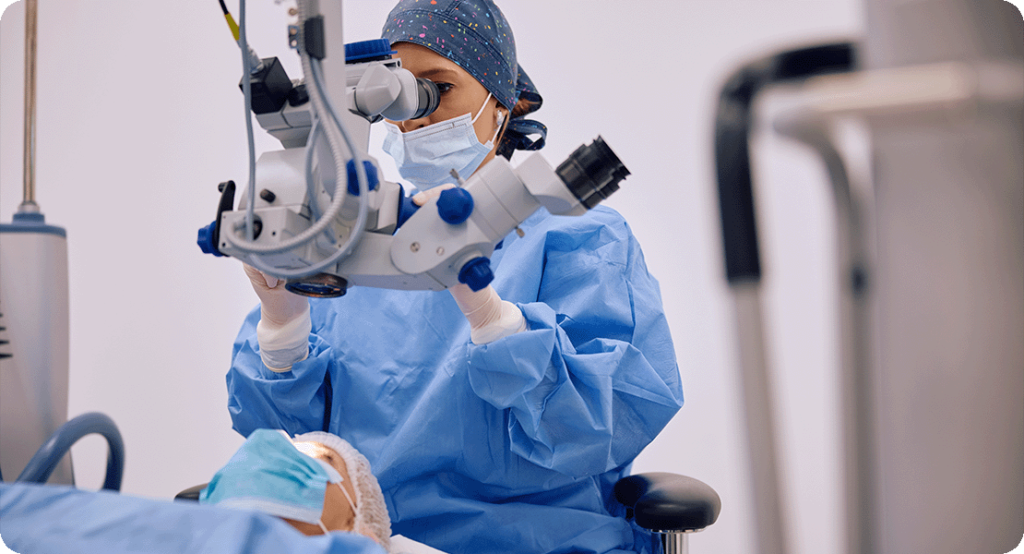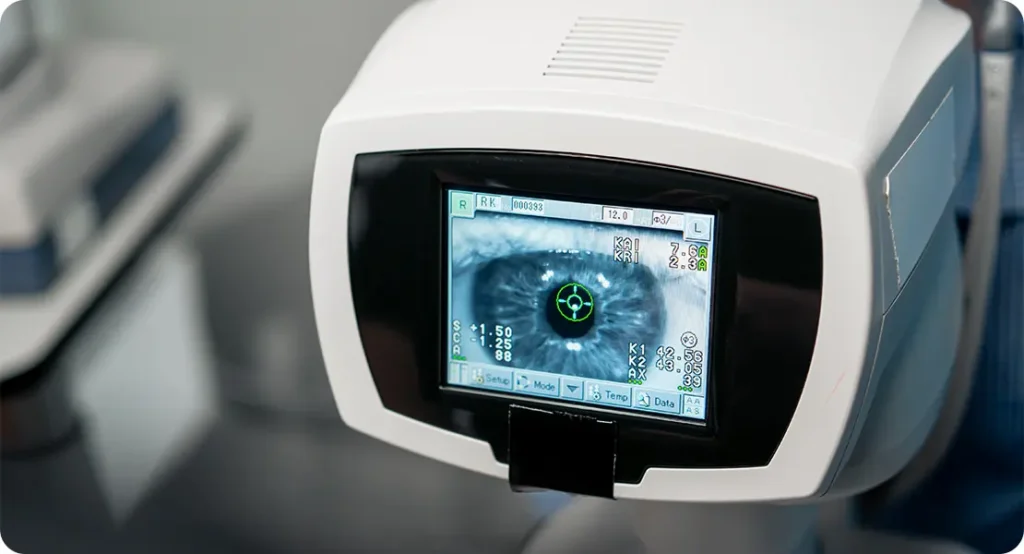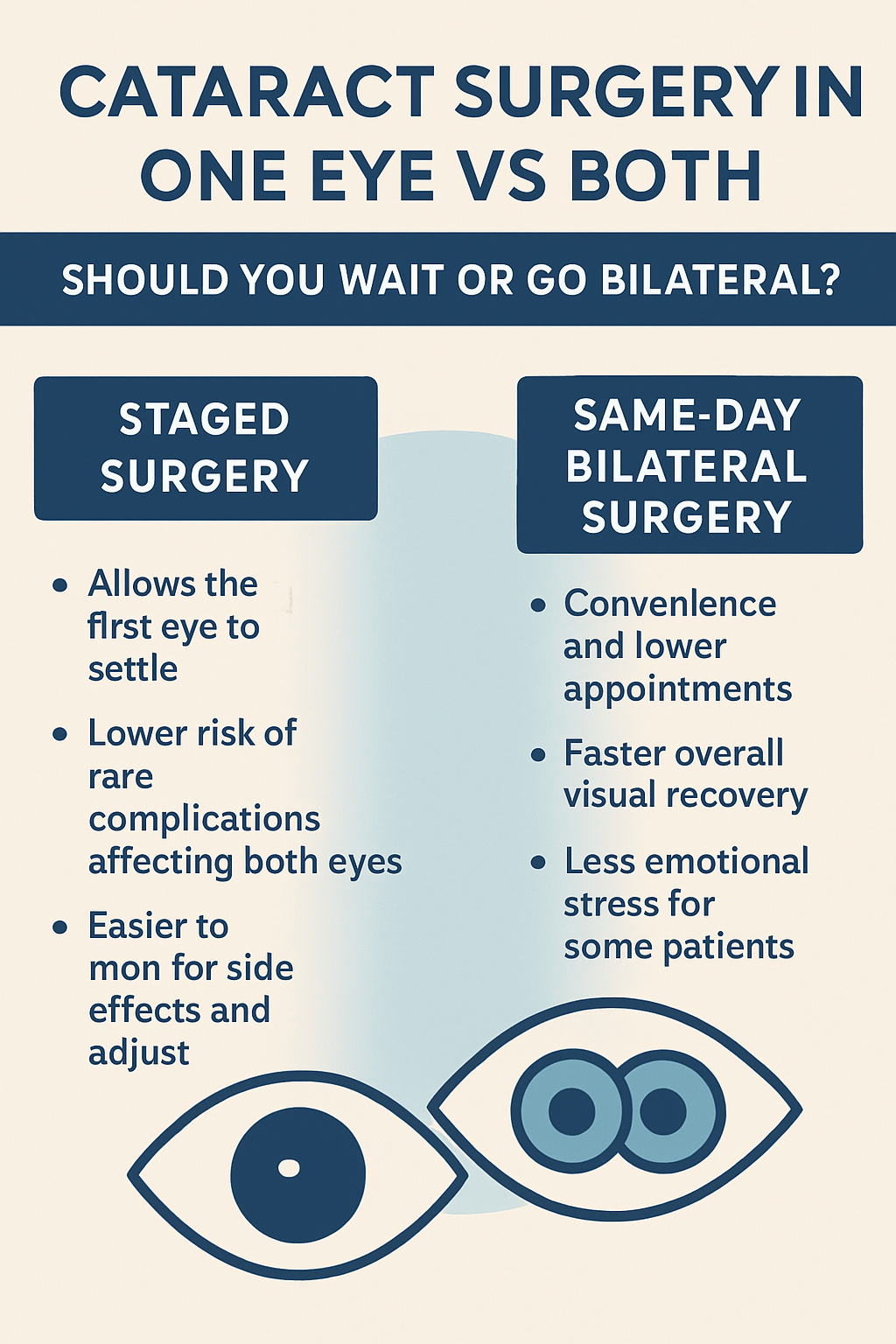So, you’ve been told you need cataract surgery. That alone can feel like a big decision—but there’s another choice that often follows close behind. Should you have surgery in one eye first and wait to do the second? Or should you go ahead and have both done at the same time?
Let’s talk through it together. In this article, I’ll guide you through everything you need to know about staged versus same-day bilateral cataract surgery. From safety and recovery to convenience and cost, we’ll break it down in plain English—so you can make the choice that’s right for you.
What Is Bilateral Cataract Surgery?
First, let’s get clear on the terminology. Cataract surgery is most commonly done on one eye at a time—especially in traditional healthcare settings. This is called staged surgery, and there’s usually a few days to several weeks between the two procedures. But with advancements in surgical techniques, same-day bilateral cataract surgery (SDBCS) has become more widely considered, especially in private clinics and some NHS trusts under specific guidelines.
Bilateral cataract surgery simply means treating both eyes during the same surgical session. While this approach was once considered a bit bold, modern improvements in lens implants, operating theatres, and post-operative care have made it a safer and more viable option for many patients.

The Case for Staged Cataract Surgery
Let’s start with the more traditional route: getting one eye done, then waiting before proceeding with the other.
Absolutely! Here’s the expanded version of each of those sub-headings, with three original paragraphs each and no duplication from any online sources:
1. It Allows the First Eye to Settle
Having cataract surgery on just one eye gives your body space to adapt and recover without being overwhelmed. Your eye needs time to heal, and while initial vision improvements are often noticeable within 48 to 72 hours, subtle shifts can continue for weeks. This window allows any residual inflammation to calm down, vision to stabilise, and your brain to begin adjusting to the new optical input from that one eye. Giving yourself this time can be a real advantage—especially if you’re sensitive to changes in your vision or prone to dry eyes or irritation post-surgery.
Another reason letting the first eye settle can be helpful is the opportunity it offers for mental and emotional adjustment. It’s not just your eye that needs to recover—your confidence often does too. Some patients feel slightly disoriented or overwhelmed immediately after surgery, even if it’s gone well. You’re suddenly seeing more clearly, sometimes with vivid colours or sharper contrast than you’re used to, which can take a little while to get used to. By going slowly, you give yourself the chance to get comfortable with the changes before doubling up the experience.
Most importantly, it gives your surgeon a chance to fully assess the results of the first operation before moving on. They can evaluate your visual acuity, check how well the new lens is functioning, and see if any post-operative adjustments are needed. If there’s anything unexpected—like swelling, discomfort, or visual aberrations—those lessons can be applied to fine-tune the plan for your second eye. In many ways, it’s a personalised approach to surgery, tailored to how your body responds in real time.
2. Lower Risk of Rare Complications Affecting Both Eyes
One of the strongest arguments in favour of staged cataract surgery is the reduced risk of serious, albeit rare, complications impacting both eyes. While cataract procedures today are extremely safe, there’s still a small chance of infection, inflammation, or surgical error. Endophthalmitis, for example, though exceedingly uncommon, can severely affect vision and, in the worst cases, lead to blindness. If you were to experience this in both eyes at once, it would obviously have a profound impact on your daily life.
By spacing the operations out—even if only by a couple of weeks—you essentially introduce a safety net. If a complication does occur in the first eye, the second remains untouched and healthy while you recover and resolve the issue. This staggered approach adds an important layer of protection, especially for individuals who already have other eye health issues or systemic conditions like diabetes, which can increase the risk of post-surgical complications.

It’s a precaution rooted in common sense. Just as pilots don’t typically test new technology on both engines at the same time, surgeons may prefer to assess the success of one eye before proceeding with the other. While bilateral same-day surgery does follow strict safety protocols—such as using separate sterile equipment for each eye—staged surgery inherently eliminates the possibility of a simultaneous complication affecting both eyes. For many people, especially those with only one good eye to begin with, that added peace of mind makes all the difference.
3. Easier to Monitor Side Effects and Adjust
Every eye has its own unique characteristics, even within the same individual. While your cataracts may appear similar, the shape of the eye, existing refractive errors, and subtle anatomical differences can all influence how each eye responds to surgery. Doing the procedures separately gives your surgeon the opportunity to study how the first eye reacts—whether there’s more inflammation than expected, slower visual recovery, or surprising sensitivity to drops—and factor that into the plan for the second eye.
There’s also the matter of lens selection. Intraocular lenses (IOLs) come in a range of types, from basic monofocal lenses to more advanced multifocal and toric options. If you’ve opted for a premium lens and aren’t thrilled with the result after your first procedure—say you’re still reaching for reading glasses more than you expected—your surgeon might adjust the choice for the second eye. You can’t do that if both lenses are implanted on the same day.

Even subtle shifts in target refraction can be made. Some people are given a ‘blended vision’ setup, where one eye is slightly better at distance and the other at near. If you find this setup difficult to adapt to after the first eye, your surgeon can reconsider the plan for the second. Staged surgery allows for this kind of real-time optimisation, helping to fine-tune your final visual result based on how you respond to the first round. It’s a more flexible, responsive approach—tailored not to textbook results, but to you.
Why People Are Choosing Same-Day Bilateral Surgery
Now let’s look at the other side of the coin—why more people today are opting to have both eyes done in a single session.
1. Convenience and Fewer Appointments
This is one of the top reasons patients love same-day bilateral surgery. You only need one set of pre-operative appointments, one trip to the operating theatre, and one round of post-op care. That’s particularly appealing if you have to travel far, rely on others for transport, or just want to get it over with.
It also saves time off work, time away from activities you enjoy, and the hassle of repeating the whole process a few weeks later.
2. Faster Overall Visual Recovery
When you have just one eye done, your brain has to adjust to the imbalance between the treated and untreated eye. Some people find this frustrating—especially if the vision in the non-operated eye is still very cloudy. You may struggle with depth perception, reading, or driving during this time.
Same-day surgery means your brain doesn’t have to do as much compensating. Both eyes heal together, and many people find they get back to normal visual function more quickly.
3. Less Emotional Stress for Some Patients
Let’s face it—surgery can be nerve-racking. Even when it’s quick and routine like cataract surgery, some people feel anxious leading up to it. If the idea of doing it all over again in a few weeks feels overwhelming, having both eyes treated at once can be a relief.
In some cases, it may actually improve outcomes—because reduced stress has been linked with better healing and post-op experiences in general.
How Safe Is Same-Day Cataract Surgery?
The short answer? Safer than it used to be—but still not for everyone.
Advances in surgical equipment, antibiotic use, and operating protocols have made SDBCS a much safer proposition than it was a decade ago. That said, the NHS and Royal College of Ophthalmologists remain cautious. For bilateral surgery to be recommended, strict protocols must be followed:
- Separate sterile instruments for each eye
- Independent surgical prep for each eye
- Two surgical teams in some cases
- Appropriate patient selection
This isn’t a casual decision. Surgeons will typically only recommend same-day surgery if you’re in good health, have no ocular comorbidities, and no increased risk of complications.
Is Bilateral Surgery Common in the UK?
It’s becoming more common—but it’s not yet the norm.
In NHS settings, staged surgery is still standard for most patients. That said, some trusts are starting to introduce bilateral procedures for selected patients under controlled conditions. In private clinics, you may have more flexibility, and same-day options might be offered more readily if you’re a suitable candidate.
It’s worth noting that same-day bilateral surgery is more widely practiced in countries like Sweden and Canada, where it’s often promoted for both patient convenience and healthcare system efficiency.
Key Things to Consider Before Deciding
This isn’t the kind of decision you want to rush through. While cataract surgery itself is one of the safest procedures out there, deciding whether to go for one eye or both at once deserves careful thought. It’s not just a medical call—it’s a personal one too. Your day-to-day routine, how you cope with stress, and the support you have around you all play a role in what’s ultimately going to work best.
A good place to start is with an open conversation with your ophthalmologist. They’ll know your eye health inside out and can help you weigh the risks and benefits based on your individual situation. But even before that chat, it helps to have a clear idea of your priorities. Are you more concerned about convenience or minimising risk? Would you rather take it slow and steady, or knock it all out in one go?

It’s also worth remembering that no two patients are exactly alike. Even if someone you know had both eyes done on the same day and had a smooth experience, that doesn’t mean the same will hold true for you. And vice versa—someone else’s rough recovery from staged surgery doesn’t mean it’s a bad option for everyone. The decision should revolve around your health, your comfort zone, and what will give you the best outcome and peace of mind.
1. Do You Have Any Risk Factors?
Your general health and any existing eye conditions can significantly influence which surgical route is safest for you. If you have diabetes, glaucoma, or macular degeneration, you might already be dealing with inflammation or structural challenges inside the eye. These conditions can make healing more unpredictable, so surgeons tend to be cautious with same-day bilateral surgery in these cases. Even something like dry eye syndrome can impact how smoothly you recover.
Another thing to think about is how you’ve responded to treatments or medications in the past. If you’ve had adverse reactions to eye drops, anaesthetics, or even simple antibiotics, that’s valuable information. It may suggest that your body could benefit from a more measured, one-eye-at-a-time approach. This lets you and your doctor monitor how you respond before committing to the second procedure.
Your age can also be a consideration—not just in terms of risk, but in terms of resilience. While plenty of older patients sail through cataract surgery with ease, others may take a bit longer to bounce back. If you’re prone to fatigue or have a few other health conditions to manage, giving yourself breathing space between procedures can make the overall experience far less taxing.
2. How Do You Feel About Recovery?
Some people like to take things slow. They feel better knowing they’ve got time to process what’s happening with their body and vision, rather than diving straight into a second procedure. With staged surgery, you get that opportunity. You can experience what life is like with one clear eye, then make a fully informed decision about when—or even if—you want to do the second.
Others are more action-oriented. They’d rather get both eyes sorted in one go, rip off the proverbial plaster, and move on. If you’re still working, have family responsibilities, or simply hate the idea of two separate recovery periods, same-day surgery might suit your lifestyle better. You’ll still need time to rest and heal, but you’ll cut down the overall disruption and get back to your normal routines faster.
The important part is recognising which camp you fall into—or whether you sit somewhere in between. Do you feel anxious about surgeries and want to limit how often you go under the knife? Or would you rather take a cautious, gradual approach and reduce your risk exposure? Knowing how you personally cope with medical procedures, downtime, and uncertainty will help you choose the route that feels less stressful in the long run.
3. Will You Need Help After Surgery?
Regardless of which approach you go for, you’ll need someone to help out after the procedure. You won’t be able to drive yourself home, and you might need support managing your eye drops, preparing meals, or just getting around safely for the first 24 to 48 hours. The difference is that with same-day surgery, you may have blurry vision in both eyes temporarily, which can make basic tasks quite tricky during those early hours.
If you’ve got a reliable support system—whether it’s family, friends, or a live-in carer—you may find same-day surgery is still very manageable. But if you live alone, or if your nearest loved one lives a few hours away, staged surgery might be the safer and more practical option. That way, even while one eye is healing, you can rely on the other to guide you through day-to-day activities.
This is one of those logistical details that often gets overlooked when patients are focused on the medical side of things. But it matters. Being able to move around confidently, read medication labels, and keep up with your hygiene routine without feeling helpless makes a huge difference to your recovery experience. So before you decide, take an honest look at what help you’ll have at home—and how comfortable you are being visually impaired in both eyes at once, even if only for a short while.

Real Stories, Real Decisions
Let’s pause for a moment and hear what others have experienced. These aren’t medical case studies—just common patterns I’ve seen in real patients’ stories.
- Elaine, 74 chose to have her surgeries a month apart. She appreciated being able to adjust to her new vision one eye at a time and liked having the reassurance of knowing how her body would react before going in for the second.
- John, 68 opted for same-day surgery at a private clinic. He lives several hours from the nearest hospital and didn’t want to travel twice. He had excellent results and was back to golfing in less than two weeks.
- Priya, 81 initially planned for staged surgery, but after struggling with poor depth perception and reading between procedures, she wished she’d gone bilateral. Her second surgery was delayed due to a hospital scheduling backlog, and she found the waiting hard to bear.

Final Thoughts: What’s Right for You?
There’s no universal “right” answer to the question of whether to go staged or bilateral. It really depends on your health, your lifestyle, and your comfort with risk versus convenience. Modern cataract surgery is incredibly safe in either scenario—but you deserve to understand the nuances before making your choice.
Here’s a quick summary to help you weigh things up:
| Factor | Staged Surgery | Same-Day Bilateral Surgery |
| Safety | Slightly lower risk overall | Safe with strict protocols |
| Convenience | Two trips, two recoveries | One trip, one recovery |
| Adjustment time | Easier to fine-tune between eyes | Both eyes adapt at same time |
| Post-op vision | One eye clear at a time | Blurry in both eyes initially |
| Suitability | Suitable for almost everyone | Only for selected patients |
Whichever path you take, cataract surgery is one of the most successful medical procedures in the world today. Whether you fix one eye at a time or both together, you’re very likely to come out of it seeing the world with a whole new level of clarity. If you’d like to discuss the matter in greater detail with one of our leading cataract surgeons, then get in touch with us at the London Cataract Centre.
So take your time, ask questions, and trust your instincts. If something doesn’t feel right, speak up. This is your vision we’re talking about—and you deserve to feel confident every step of the way.

